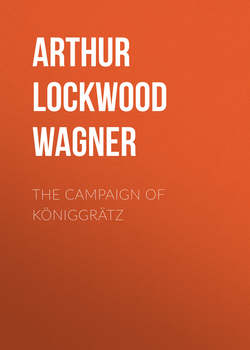Читать книгу The Campaign of Königgrätz - Arthur Lockwood Wagner - Страница 6
THE CAMPAIGN OF KÖNIGGRÄTZ
OPERATIONS AGAINST THE HESSIANS AND HANOVERIANS. 2
ОглавлениеVon Falckenstein from Minden, and Von Manteuffel from Altona, moved upon Hanover, and Von Beyer invaded Hesse-Cassel from Wetzlar. On the night of the 15th the Hanoverian army, accompanied by the blind monarch, King George, retreated, chiefly by rail, to Göttingen; the retreat being conducted in such haste that even the reserve ammunition and hospital supplies were left behind. On the 17th Von Falckenstein entered the Hanoverian capital; on the 19th Von Manteuffel marched into the city; and by the 22d all Hanover, except Göttingen, was in the possession of the Prussians.
Von Beyer pushed into Hesse-Cassel, the Hessian army retiring before him, by way of Fulda, upon Hanau, where it formed a junction with the Federal forces. On the 19th the Prussians entered Cassel, and an army was thus placed across the path of the retreating Hanoverians.
The Hanoverian army, which had been compelled to wait several days at Göttingen to complete its organization, resumed its march on the 21st, intending to cross a portion of the Prussian territory via Heiligenstadt and Langensalza, and thence through Eisenach or Gotha, to form a junction with the Bavarians in the neighborhood of Fulda. Von Falckenstein pursued from Hanover, detachments were sent from Magdeburg and Erfurt to Bleicherode and Eisenach, and Von Beyer occupied the line of the Werra between Allendorf and Eisenach. Though the route through Eisenach was thus blocked, energetic measures on the part of the allies might easily have extricated the Hanoverian army from the constricting grasp of the Prussians. Gotha was occupied by a weak force of six battalions, two squadrons and three batteries, while the retreating army numbered 20,500 men. Had the Bavarian army been well prepared and ably led, a junction might have been formed with the Hanoverians, and the Prussian force at Gotha captured. But the Bavarian commander was inefficient, and the over-estimate placed by King George upon the number of his enemies at Gotha was strengthened by the receipt, from the commander of the petty force, of an audacious summons to surrender. Negotiations were entered upon by the Prussian and Hanoverian representatives; but the armistice (begun on the 24th and continued until the 26th) produced no other result than the reinforcement of the force at Gotha; General Von Flies, with five battalions, being detached from Von Falckenstein’s army, and sent by rail, via Magdeburg and Halle, to Gotha.
At Treffurt, Kreutzberg, Eisenach and Gotha, points on a semi-circle in front of the Hanoverians, and within a day’s march of them, were nearly 30,000 Prussians.
On the 27th General Von Flies, advancing through Warza upon Langensalza, with about 9,000 men, struck the army of King George, which was well posted on the left bank of the Unstrut river. A battle followed, in which the Hanoverians defeated Von Flies, and drove his army several miles towards Warza.
But the Hanoverian victory was a barren one. Von Flies was reinforced at Warza by a strong detachment from Von Goeben’s division at Eisenach. Von Goeben and Von Beyer advanced from Eisenach upon Langensalza, and Von Manteuffel, moving via Heiligenstadt, Worbis, Dingelstadt, Mühlhausen and Gross Gottern, closed upon the Hanoverians from the north. The army of King George was now surrounded by 40,000 Prussians, united under the command of Von Falckenstein. Further resistance was hopeless, and on the 29th of June the Hanoverians surrendered. The men were dismissed to their homes, the officers were paroled, and King George was banished from his kingdom.
